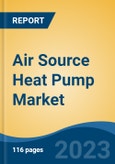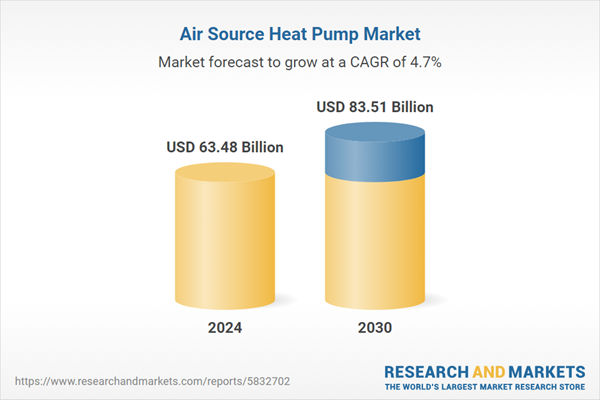Speak directly to the analyst to clarify any post sales queries you may have.
10% Free customizationThis report comes with 10% free customization, enabling you to add data that meets your specific business needs.
Key Market Drivers
Rising Demand for Energy-Efficient Heating and Cooling Solutions
One of the most significant drivers of the Air Source Heat Pump market is the increasing global emphasis on energy efficiency. With growing awareness of climate change and the need to reduce reliance on fossil fuels, both consumers and governments are actively seeking alternatives to conventional heating and cooling systems. Air source heat pumps, which transfer heat rather than generate it by combustion, consume significantly less electricity compared to electric resistance heaters or traditional HVAC systems. This leads to substantial energy savings over the system’s lifecycle.In regions where electricity prices are high, the operational cost benefits become even more pronounced, prompting residential and commercial property owners to invest in ASHPs. Additionally, as building codes and energy performance standards become more stringent worldwide, developers and facility managers are increasingly adopting these systems to meet regulatory compliance and enhance building efficiency ratings. The rising integration of energy efficiency certifications, such as LEED (Leadership in Energy and Environmental Design) and BREEAM (Building Research Establishment Environmental Assessment Method), further encourages adoption, as ASHPs contribute to achieving higher sustainability scores.
Key Market Challenges
High Initial Investment and Installation Costs
One of the most significant barriers to the widespread adoption of air source heat pumps is the relatively high upfront cost compared to conventional heating and cooling systems. While ASHPs deliver substantial energy savings over their operational life, the initial purchase price, coupled with installation expenses, can be prohibitive for many households and small businesses.The cost is influenced by factors such as system size, building type, the complexity of installation, and the need for supplementary upgrades, such as improved insulation or compatible ductwork. In some regions, the lack of experienced installers can further raise labor costs. Although government subsidies and incentives help offset these expenses, not all markets have robust financial support programs, and in certain areas, consumers may remain hesitant to invest in a system that requires a higher initial outlay.
Key Market Trends
Integration of Smart and Connected Technologies
A significant trend in the ASHP market is the integration of smart home and connected technologies, enabling advanced control, monitoring, and optimization of system performance. Modern ASHPs are increasingly being equipped with Wi-Fi connectivity, app-based controls, and integration with smart home ecosystems like Google Home, Amazon Alexa, and Apple HomeKit. These features allow users to remotely adjust temperature settings, monitor energy consumption, and receive maintenance alerts, enhancing both convenience and energy management.Advanced data analytics and AI-powered algorithms are also being incorporated to optimize performance based on user habits, outdoor weather conditions, and electricity pricing patterns. This results in improved efficiency, reduced energy bills, and an enhanced user experience. The trend aligns with broader shifts in the HVAC industry toward IoT-enabled solutions, as consumers increasingly expect seamless control and customization of home systems.
Key Market Players
- Vaillant Group
- Swegon Group AB
- Robert Bosch GmbH
- Trane Technologies Company, LLC
- NIBE Industrier AB.
- Rheem Manufacturing Company
- Viessmann Group
- A.O. Smith Corporation
- Daikin Industries, Ltd.
- Carrier Global Corporation
Report Scope:
In this report, the Global Air Source Heat Pump Market has been segmented into the following categories, in addition to the industry trends which have also been detailed below:Air Source Heat Pump Market, By Process:
- Air to Air
- Air to Water
Air Source Heat Pump Market, By End Use:
- Residential
- Hotels & Resorts
- Gym & Spas
- Education
- Food Service
- Others
Air Source Heat Pump Market, By Sales Channel:
- Plumbers
- Dealers & Contractors
- Retail
- Direct Sales
- Online
- Others
Air Source Heat Pump Market, By Region:
- North America
- United States
- Canada
- Mexico
- Europe
- France
- United Kingdom
- Italy
- Germany
- Spain
- Asia-Pacific
- China
- Japan
- India
- South Korea
- Indonesia
- South America
- Argentina
- Colombia
- Brazil
- Middle East & Africa
- South Africa
- Saudi Arabia
- UAE
- Turkey
Competitive Landscape
Company Profiles: Detailed analysis of the major companies present in the Global Air Source Heat Pump Market.Available Customizations:
With the given market data, the publisher offers customizations according to a company's specific needs. The following customization options are available for the report.Company Information
- Detailed analysis and profiling of additional market players (up to five).
This product will be delivered within 1-3 business days.
Table of Contents
Companies Mentioned
- Vaillant Group
- Swegon Group AB
- Robert Bosch GmbH
- Trane Technologies Company, LLC
- NIBE Industrier AB.
- Rheem Manufacturing Company
- Viessmann Group
- A.O. Smith Corporation
- Daikin Industries, Ltd.
- Carrier Global Corporation
Table Information
| Report Attribute | Details |
|---|---|
| No. of Pages | 181 |
| Published | September 2025 |
| Forecast Period | 2024 - 2030 |
| Estimated Market Value ( USD | $ 63.48 Billion |
| Forecasted Market Value ( USD | $ 83.51 Billion |
| Compound Annual Growth Rate | 4.7% |
| Regions Covered | Global |
| No. of Companies Mentioned | 10 |









